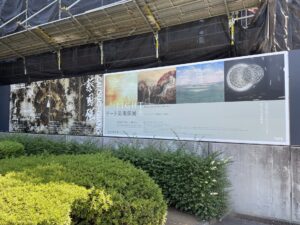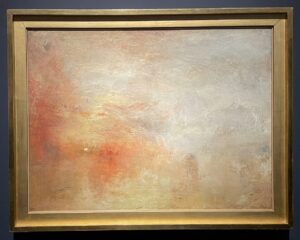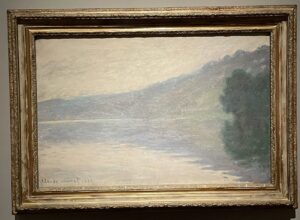Aiming for the first day of ” Light, Works from the Tate Collection” Exhibition
We (assistant No. 0 and I) headed to the National Art Center, Tokyo in Roppongi to see the “Light, Works from the Tate Collection” Exhibition (“Tate Museum Exhibition”) on July 12 (Wednesday), the opening day of the exhibition.
We aimed to 10:00am, the open time, but arrive about 10 minutes before.
It was already hot and we were sweating just by walking outside.
According to the World Meteorological Organization (WMO), June this year was the hottest month on record, and on July 7, the average global temperature hit a new high.
The heat makes us feel that global warming is finally affecting our lives.

「テート美術館展」と<29>話で紹介した「蔡國強展」は同時に開催されている。

Well, the inside of the museum where I managed to reach was cool, and I felt comfortable just by entering.
We put our luggage in the locker and took the escalator to the second floor.
By the way, the “Cai Guo-Qiang Exhibition” was still being held on the first floor.

There was already a line of about 10 meters, but it wasn’t as long as I had expected, and I was able to enter smoothly at 10 o’clock.
We already bought advance tickets online about a month ago, so we entered with a QR code on my smartphone.
It was easy this way.
Well, I was looking forward to what kind of (relating-Expo) discoveries this art exhibition would bring.
Tate Museum in London
I have visited the Tate Museum in London several times.
The first time I visited was over 30 years ago.
The last time I visited Tate Britain was in the fall of 2019. It was right before the coronavirus pandemic hit, and in retrospect, I’m glad we traveled to London at that time.

テート・ブリテン エントランス 2019年筆者撮影
Tate Britain Entrance Photographed by the author in 2019
I stayed at a hotel near St. James’ Park, so Tate Britain is within walking distance. It had been a long time since I’d visited the museum, and there were so many wonderful works by Turner (1775-1851) and Constable (1776-1837) that I couldn’t help but spend a lot of time there.
Between September 11, 2019 and February 2, 2020, an exhibition of William Blake (1757-1827), which is also included in this exhibition, was also held.

テート・ブリテン ウィリアム・ブレークの展覧会フラッグ
2019年筆者撮影
Tate Britain, William Blake Exhibition Flag
Photographed by the author in 2019
I went to Tate Modern in 2016. I was on a business trip at the time, but when I had some free time, I skipped a taxi and went there.
The Tate Modern, which was built by renovating the former power plant, has been gaining popularity in Japan also for some time, so I thought I had to visit it at least once.
Standing along the River Thames, a tall square tower resembling an old factory chimney is eye-catching. This museum opened in 2000.
Designed by Herzog & de Meuron (also designed Beijing National Stadium “Bird’s Nest”.
Please refer to <27> “Cai Guo-Qiang Ramble in the Cosmos – From Primeval Fireball Onward” Exhibition).
When I visited London again in 2019, I was able to see the Tate Modern building from a sightseeing boat on the River Thames.

テート・モダン 2019年 船より筆者撮影
Tate Modern Photographed by the author from the ship in 2019
I had thought there were only these two Tate museums, but according to the explanation of this art exhibition, I found out that there are two more. They were “Tate Liverpool” and “Tate St. Ives“.
The theme of this exhibition is “light”, and about 120 works are on display.
In terms of era, it is wide ranging from William Blake, Turner and Constable to contemporary artists.

ウィリアム・ブレイク『アダムを裁く神』
William Blake “God Judging Adam”

ウィリアム・ブレイク『善の天使と悪の天使』
William Blake “The Good and Evil Angels”

ジョゼフ・マロード・ウィリアム・ターナー『陽光の中に立つ天使』
Joseph Mallord William Turner “The Angel Standing in the Sun”

ジョゼフ・マロード・ウィリアム・ターナー『陰と闇 ー 対洪水の夕べ』
Joseph Mallord William Turner “Shade and Darkness – the Evening of the Deluge”

ジョゼフ・マロード・ウィリアム・ターナー『湖に沈む夕日』
Joseph Mallord William Turner “Sun Setting over a Lake”
In each case, works that make you feel the theme of “light” have been selected.
Claude Monet and the World Expos
There were also works such as Claude Monet’s (1840-1926) “Poplars on the Epte” and “the Seine River at Port-Villez”.

クロード・モネ『エプト川のポプラ並木』
Claude Monet “Poplars on the Eptes”

クロード・モネ『ポール=ヴィレのセーヌ川』
Claude Monet “The Seine at Port-Villez”
Monet is also a painter who has a deep connection with Expos.
At the 1889 Paris Universal Exposition, the “100 Years Retrospective Exhibition of French Paintings” was held at the “Palais des Beaux-Arts” of the Champ de Mars.
652 oil paintings and 140 sculptures from the time of the French Revolution in 1789 to 1889, the year of the Universal Exposition, were exhibited at the Palais des Beaux Arts. Along with Manet, Pissarro, and Cézanne, three works by Monet, including “Tuileries Garden,” were also exhibited at the exhibiiton.
Monet’s work related to the Universal Exposition includes “Rue Montorgueil, Paris, Festival 30 Juin, 1878”.
It depicts the hustle and bustle of Paris, filled with French flags, on June 30, which became a public holiday celebrating the success of the third Paris Universal Exposition, which had been held since May 20, 1878.
This work was not exhibited at the 1878 Paris Universal Exposition, which had already begun, but it was exhibited at the 4th Impressionist Exhibition the following year, along with “Rue Saint-Denis, Fest des Juin 30, 1878”, which had almost the same composition.

クロード・モネ『パリのモントルグイユ街、1878年6月30日の祝祭』
Claude Monet “Rue Montorgueil, Paris, Festival 30 juin, 1878”

クロード・モネ『サン=ドニ街、1878年6月30日の祝祭』
Claude Monet “Rue Saint Denis – Fest des 30 Juni 1878”
At the 1889 Paris Universal Exposition, the fourth exposition held in Paris, Monet exhibited three works as mentioned above.
There is also an anecdote that when Monet heard that Manet’s “Olympia” exhibited at the Universal Exposition would be sold to the United States, he raised money with the goal of raising 20,000 francs to prevent it from leaking overseas.
The Encounter of Monet and “Water Lilies”
In fact, Monet had a fateful encounter at the Paris Exposition of 1889.
It was the encounter between Monet and “water lilies”.
“Water lily” this time is not the name of the work, but the plant “water lily”.
I wrote about this story in detail in ‘Episode 40 “Monet’s ‘Water Lilies’ were also Born at the Expo!?”’ of my book “EXPO 100 Stories 1851-2025“ (Yoshimoto Books, 2022), so please refer to it for the details.
Below are the key points;
At that time in France, if you say “water lily flowers”, it only meant “white” flower.
However, a person named Joseph Bolly Latour-Marliac (1830-1911) succeeded in producing pink water lilies through cross-breeding, and after that the colors increased.
It was at the 1889 Paris Universal Exposition that Latour-Marliac exhibited the newly developed water lilies of various colors.
This exhibition became very popular, and after seeing it, Monet grew various water lilies himself and painted them in his works.
In other words, Monet’s “Water Lilies” series, which everyone knows, began with a fateful encounter at the 1889 Paris Universal Exposition. Without the encounter with a new type of water lily at the Paris Expo, this series of masterpieces might not have been born.
Works of Hammershøi
As I walked through the venue, thinking about such an episode about Monet and the Expo, I found two works that I could recognize at a glance as works by Vilhelm Hammershøi (1864-1916).
These are “Interior” (1899) and “Interior, Sunlight on the Floor” (1906).

ヴィルヘルム・ハマスホイ『室内』
Vilhelm Hammershøi “Interior”

ヴィルヘルム・ハマスホイ『室内、床に映る陽光』
Vilhelm Hammershøi “Interior, Sunlight on the Floor”
The commentary on “Interior” in the exhibition catalog reads as follows. (P231)
*
…This painting, which portrays one of the rooms in Hammershøi’s home at Strandgade 30, Copenhagen, was made soon after he had moved into the seventeenth-century property with his wife, Ida. Hammershøi painted the rooms of this house more than sixty times, often without people, though sometimes, as here, showing the space occupied by a figure, modelled in this instance by Ida. (Omitted below)
*
This work depicts a quiet room.
Hammershøi’s unique taste draws us in without even realizing it.
Regarding these two works, I feel like I’ve seen both of them somewhere before, or perhaps I’ve seen something with a similar composition.
In fact, Hammershøi painted this room more than 60 times, and his wife, Ida, who is also depicted from behind in this painting, was also often depicted as a model, so it is not surprising to see similar paintings.
“Vilhelm Hammershøi and Danish Painting of the 19th Century” exhibition held in 2020
In fact, three years ago, from January 21 to March 26, 2020, the Tokyo Metropolitan Art Museum held an exhibition called “Vilhelm Hammershøi and Danish Painting of the 19th Century “ (then, from April 7 to June 7, it was held at the Yamaguchi Prefectural Museum of Art).
At that time, I visited with my assistant No. 0, and the impression of Hammershøi’s work at that time was great.
However, even if it is called “Hammershøi” or “Danish painting“, ordinary people may not be very familiar with it.
The “Foreword” in the catalog of this exhibition reads as follows.
*
Copenhagen, the capital of Denmark, saw the development of a wide array of Europe’s fin-de-siècle art styles, from Post Impressionism to Symbolism, Cubism and Expressionism, around the year 1900. Vilhelm Hammershøi (1864-1916) distanced himself from the clamor of these mainstream trends and limited himself to quietly depicting portraits of his circle, landscapes and interior scenes bathed in stillness.
These unique, quietly subdued paintings garnered great praise for Hammershøi from both Danish and overseas audiences. While forgotten for a time after his death, from the late 1990s onwards a succession of retrospective exhibitions have been held in European and American museums, and today he is once again renowned. Japan saw its first Hammershøi exhibition in 2008, an exhibition that left a strong impression on Japan’s art fans.
*
For some reason, the number of “quiet interiors” that Hammershøi “painted silently” is strangely poignant.
Perhaps Hammershøi was influenced by 17th-century Netherlandish painters such as Vermeer (1632-1675). There are many things in common with the repeatedly drawn interior, light, and female model.
By the way, the exhibition at that time was divided into four parts.
1. In Praise of Everyday Life – The Golden Age of Danish Painting
2. Light, Landscape and the Artistic Life of Skagen
3. Turn of the Century – Diversity and the Rise of Painting Interiors
4. Vilhelm Hammershøi – In the Urban Solitude and Silence
The continuation of the “foreword” quoted earlier is as follows.
*
Denmark has ranked first several times in the United Nations World Happiness Report and thus today is known as the ‘happiest country in the world’. The paintings of everyday scenes produced in 19th century Denmark can be seen as the model of hygge, that which embodies a sense of comfortable ease most highly regarded in Denmark. (Bold letters are by the author. Same below.)
*
In “3. Turn of the Century – Diversity and the Rise of Painting Interiors”, several works that give a sense of this “hygge” were exhibited. A representative example is Viggo Johansen’s “Silent Night”.
Parents and children are holding hands and surrounding a bright Christmas tree. This laid-back, joyful atmosphere is what they would call “hygge”.
And in the final “4. Vilhelm Hammershøi – In the Urban Solitude and Silence,” 37 paintings by Hammershøi were exhibited.
There were also landscape paintings and works depicting the exterior of houses, but it is the interior paintings that are of interest.
Some of his works depict empty rooms with open doors, devoid of any furniture.
There is also a lonely atmosphere, like a room after moving out of the room where you lived for many years, and thinking that you will never come back to the room.
In this exhibition as well, three works depicting the interior and the back view of his wife, Ida, were on display.
Many of Ida’s works are drawn from behind, and some people may think that she may be a model for “no appearance”, but in fact, in the 2020 exhibition, several works in which Ida’s face was drawn from the front were also exhibited.
“Interior, Sunlight on the Floor” and “Sitting Room. Study in Sunlight, Strandgade 30”
In addition, “Interior, Sunlight on the Floor” (1906), which is exhibited at the “Tate Museum Exhibition” this time, seems to be exactly the same work as the one exhibited at “Vilhelm Hammershøi and Danish Painting of the 19th Century ” in 2020.
The title of the work is “Sitting Room. Study in Sunlight, Strandgade 30” (1906).
Both of these two works were painted in 1906, and the one “Sitting Room. Study in Sunlight, Strandgade 30” was used as a motif for a large exhibition sign at the Tokyo Metropolitan Art Museum.

2020年開催「ハマスホイとデンマーク絵画」展
“Vilhelm Hammershøi and Danish Painting of the 19th Century” exhibition held in 2020
Is it the same work?
When I looked it up, I found that this “Sitting Room. Study in Sunlight, Strandgade 30” is not owned by the Tate Museum, but by “Davis Collection”.
Furthermore, if you look closely at the Tate Museum’s “Interior, Sunlight on the Floor”, you can see just a little bit of a table with a white tablecloth on the far left.
Also, the lighting is slightly different.
Judging from the title, is it possible that the study for this Tate Museum’s “Interior, Sunlight on the Floor” is a work from the ‘Davis Collection’?
Furthermore, in the catalog of “Vilhelm Hammershøi and Danish Painting of the 19th Century” (p. 172), another work with a similar composition depicting the same room is introduced.
It is called “Dust in the Sunlight, Strandgede 30”, drawn in 1900 at the Ordrupgaard Museum (a museum located in the northern part of Copenhagen, Denmark).
According to the commentary, “At least 15 variations of the work depicting this room are known today.”
Indeed, 15 paintings were drawn with the same composition.
In the “Tate Museum Exhibition” this time, Hammershøi’s works were the only two works mentioned above, but even these alone were quite enjoyable.
Hammershøi and the Expo
By the way, if you are an avid reader of “Banpakutei Niichijo (Life with Expo)”, you will soon realize why I am talking about ” Hammershøi ” at length.
Yes, Hammershøi was also an artist who are related to the World Expo.
And he won a bronze medal.
In the chronology (P189) of the catalog of “ Vilhelm Hammershøi and Danish Painting of the 19th Century ” held in 2020, there is the following in 1889.
*
Hammershøi exhibits four works at the Paris Universal Exposition and won a bronze medal. Hammershøi, who was visiting Paris at this time, tried to climb to the top of the newly completed Eiffel Tower on June 15, the birthday of his mother Fredereghe, but gave up on the way and turned back due to too much congestion.
*
The 1889 Paris Universal Exposition is famous for the construction of the Eiffel Tower, and is the fourth Paris Universal Exposition following 1855, 1867, and 1878.
This exposition was held to commemorate the 100th anniversary of the French Revolution and boasted more than 32 million visitors.
The Eiffel Tower is probably the most popular topic, but Edison also exhibited a telephone and a gramophone and gave a demonstration himself.
In art, Henri Rousseau painted a self-portrait against the backdrop of the 1889 Paris Universal Exposition in his work titled “Self-portrait” (1890, Prague National Museum).
The Eiffel Tower is also drawn in the background.

アンリ・ルソー『私自身、肖像=風景』
(1890年、プラハ国立美術館)
Henri Rousseau, Self-portrait (1890)
National Gallery, Prague
Hammershøi was a so-called “exhibitor” who exhibited works at the Expo, but according to the above, it seems that he was not given priority entrance (?) to the Eiffel Tower.
By the way, celebrities who have a record of climbing the Eiffel Tower during the 1889 Paris Universal Exposition includeBritish Prince of Wales Edward, Thomas Edison, and popular actress Sarah Bernhardt.
Natsume Soseki also climbed the Eiffel Tower from Japan, but it was at the time of the 1900 Paris Universal Exposition when he stopped by on his trip to study in London.
Well, setting aside the Eiffel Tower, what kind of works are the “four works” exhibited by Hammershøi?
Unfortunately, the catalog does not provide any further information.
Therefore, I decided to investigate the art exhibition catalog materials of the 1889 Paris Universal Exposition that I treasured at the Banpakutei.
This material is an exhibition catalog by country, and 190 paintings and 17 sculptures are listed in the “DANEMARK (Denmark)” section.
And the “work numbers 44 to 47” are Hammershøi’s works.
Those works are the following 4 works;
44 “Etude” (Study)
45 “Vieille femme” (Old woman)
46 “Jenne fill” (Young girl)
47 “Job” (Job)
Unfortunately, however, neither the 37 works exhibited in“Vilhelm Hammershøi and Danish Painting of the 19th Century” in 2020, nor the two works exhibited in this year’s ”Tate Museum Exhibition”, include these four works.
On the Internet, there are things that make me wonder if it might be the work, but when I search with the same title, “Old woman,” for example, I find multiple paintings with the same title.
The author’s treasured materials do not include the year of production of the work, so it is quite difficult to search further. If anyone knows, I would love to hear from you.
At the 1889 Paris Universal Exposition, the same year that Monet “discovered” the motif of his representative work, the “Water Lilies” series, Hammershøi of Denmark exhibited four works and won a bronze medal.
In general information, the relationship between artists, works, and the World Expo is often not mentioned at all.
In fact, however, the influence of the World Expo is widespread.
It was an exhibition that made me re-recognize such a thing.



